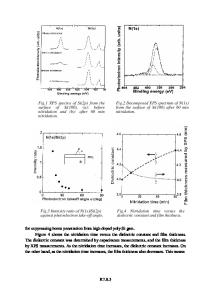Spectroscopic and Electrical Properties of Ag 2 S/PVA Nanocomposite Films for Visible-Light Optoelectronic Devices
- PDF / 977,360 Bytes
- 8 Pages / 595.276 x 790.866 pts Page_size
- 84 Downloads / 318 Views
Spectroscopic and Electrical Properties of Ag2S/PVA Nanocomposite Films for Visible‑Light Optoelectronic Devices Sami S. Alharthi1 · Ahmed Alzahrani2,3 · M. A. N. Razvi2 · Ali Badawi1 · Mohammed G. Althobaiti1 Received: 8 March 2020 / Accepted: 23 March 2020 © Springer Science+Business Media, LLC, part of Springer Nature 2020
Abstract Polymer nanocomposites are potential materials in the industrial sector and in our daily life due to their diverse properties and applications. Throughout the present study, solution casting technique has been used to prepare polyvinyl alcohol (PVA) filled with different weight (wt.) ratios percentages (%) (0, 0.01, 0.1, 1.0 and 10.0 wt%) of silver sulfide nanoparticles (Ag2S NPs). The concentration dependence of spectroscopic and electrical behaviors based on PVA polymer dispersed with A g 2S has been investigated. The prepared films with the variation of loading filler concentrations from 0 to 10 wt% have been characterized by different spectroscopic techniques. Fourier transform infrared (FTIR) analysis confirmed the successful incorporation of A g2S nanoparticles in the PVA matrix by studying the changes of the characterizing bands which reveal the interaction within the composite structure. Whilst photoluminescence (PL) spectra of the A g2S/PVA nanocomposite films showed an interesting peak covering the entire range of interest for visible light optoelectronic devices at a very low concentration of the loading filler of A g2S. The electrical properties of the plain and A g2S NPs doped PVA nanocomposites have been studied using DC electrical conductivity (σDC) measurements performed over a temperature (T) range from 298 to 373 K. The study demonstrates the increase of the DC electrical conductivity with increasing filler content of A g2S by three orders of magnitude. DC conductivity also showed temperature dependent behavior where the conductivity enhanced by five orders of magnitude when temperature increased up to 373 K. These novel results present A g2S/PVA nanocomposites as a promising material in optoelectronics applications. Keywords Ag2S · PVA nanocomposites · Photoluminescence · FTIR spectroscopy · DC conductivity · Optoelectronic devices
1 Introduction Over the past few years, intensive research activities in the fabrication of polymer nanocomposites have been of great interest due to their novel structural, electrical and optical properties on top of the polymer inherent properties such as ease of processability, flexibility, high mechanical strength. The incorporation of conducting and semiconducting nanomaterials into polymer matrices can significantly enhance * Sami S. Alharthi [email protected] 1
Physics Department, Faculty of Science, Taif University, P.O. Box 888, Taif 21974, Saudi Arabia
2
Physics Department, Faculty of Science, King Abdulaziz University, P.O. Box 80203, Jeddah 21589, Saudi Arabia
3
Center of Nanotechnology, King Abdulaziz University, P.O. Box 80203, Jeddah 21589, Saudi Arabia
their properties and makes them unique
Data Loading...










